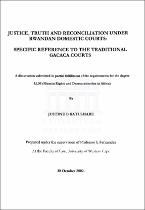| dc.contributor.advisor | Fernandez, L | |
| dc.contributor.author | Katushabe, Justine B | |
| dc.date.accessioned | 2023-05-17T09:41:26Z | |
| dc.date.available | 2023-05-17T09:41:26Z | |
| dc.date.issued | 2001 | |
| dc.identifier.uri | http://hdl.handle.net/11394/10014 | |
| dc.description | Magister Legum - LLM | en_US |
| dc.description.abstract | lmmediately after the 1994 genocide in Rwanda, the government of national unity faced the onerous task of reconstructing a country laid desolate by the forces of genocide.The infrastructure was destroyed, and human resources decimated. The Government also had the difficult task of bringing the perpetrators of genocide to justice, thus breaking the culture of impunity that has characterized Rwanda for over 30 years. At the same time, the new Government had to build the foundations for a stable, inclusive society, based on tolerance, respect for fundamental human rights, and dedicate itself to promoting national unity and reconciliation. | en_US |
| dc.language.iso | en | en_US |
| dc.publisher | University of the Western Cape | en_US |
| dc.subject | Rwandan domestic courts | en_US |
| dc.subject | Justice | en_US |
| dc.subject | International human rights law | en_US |
| dc.subject | Genocide | en_US |
| dc.subject | Traditional methods of conflict resolution | en_US |
| dc.title | Justice, truth and reconciliation under Rwandan domestic courts: specific reference to the Gacaca courts | en_US |
| dc.rights.holder | University of the Western Cape | en_US |

